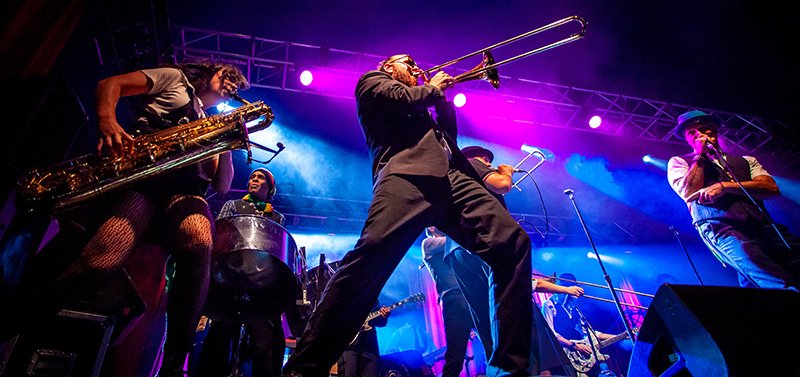Arts, culture and creative expression are fundamental to Australian identity. International and Australian research indicates Australians’ high rate of participation in cultural and creative activities helps us develop a sense of belonging, forges social cohesion, stimulates curiosity, enhances our ability to engage with different perspectives, and has a range of benefits to health and wellbeing.
The cultural and creative industries are also proven drivers of innovation. Unfortunately, data suggests this is an area where Australia is falling behind. The 2021 Global Innovation Index ranks Australia 25th in the world, down from 14th in 2014.
To drive innovation, diversification and economic growth, Australia needs to enhance its population’s opportunities to gain, develop and experience creative skills.
Middle Australians agree. Ongoing research, conducted by A New Approach (ANA) since 2020, demonstrates that this demographic directly links developing new ideas and adapting to change with access to opportunities for cultural and creative experiences and expression.
These middle-income swing voters living in outer suburban and regional locations want all Australians – especially young people – to have opportunities to develop creative skills.
The voices of middle Australians, and their overwhelming support for arts and culture as drivers of ideas, adaptation and connection, should empower us as a nation to act boldly and prioritise creativity as a foundation for future innovation.
Doing this will lead to a stronger, more resilient and adaptable national economy and society that will help advance Australia’s position on the global stage.

An economy at risk of decline
Beyond our falling international innovation ranking, there are concerning indications that Australia’s economic vitality is at risk.
According to a global study, Australia’s ranking for economic complexity dropped from 57th to 86th between 1995 and 2019. The study observed that ‘…countries whose exports are more complex than expected for their income level, grow faster,’ with a country’s future growth potential directly linked to its diversification of exports
It noted Australia has ‘…diversified into too few products to contribute to substantial economic growth.’
In research and development, another common measure of innovation performance, Australia is well below the average for countries in the Organisation for Economic Co-operation and Development (OECD).
Australia’s Innovation Agenda, which sets out the nation’s approach to research and development, puts significant focus on scientific and technical innovation but tends to exclude cultural and creative innovation.
ANA research suggests that this narrow focus and lack of diversification is detrimental to Australia’s economic growth, and will have negative impacts on the effectiveness, innovation and adaptability of our future workforce.
The future of work
The Fourth Industrial Revolution is upon us. Given the exponential rate of technological breakthroughs and their ensuing disruptions to industry, we know systems of production, management and governance are changing rapidly.
This unprecedented level of transformation highlights the increasing urgency for Australia to prepare for the future of work.
The diverse range of skills that drive innovation – skills related to creativity, communication, business management and analysis – will become increasingly in demand in the future.
Employees will be expected to have these social, interpersonal and lateral thinking skills in their tool kit even if they have specialised in a technical field. Workforces comprising employees with these skills are more likely to thrive in high-tech economies and be better positioned to meet the demands of the future.
Given that success increasingly depends on workers’ ability to adapt and innovate, there is a clear path forward for Australia. Developing creative skills within individuals across every industry will be crucial to preparing Australia for the future of work.
The people have spoken
In Australia, there is an acknowledged need for innovation to diversify the economy, develop new industries and increase productivity. There is also evidence to suggest that creativity is key to driving this.
However, any public policy change also needs to consider public sentiment and beliefs. What does the broader Australian public believe about the relationship between creativity and innovation?
Middle Australians – particularly young middle Australians – directly link access to arts and cultural experiences with new industries, new careers and building the skills needed for the future.
They also report that arts and culture encourages them to be open to new ideas and inspires new ways of thinking about existing challenges.
Importantly, they stress the importance of arts and cultural education from a young age to ensure today’s children are well prepared for innovation in the workforce.
In early 2020, mid-2021 and mid-2022, ANA held a series of focus groups with middle Australians. When asked about the impact of arts and culture, participants from around the country said:
I think it has a huge effect on skills…it forces us to think in a different way and allows you to develop your own thoughts and your own thought processes…it teaches you to think for yourself, teaches you to work with other people. (Female, South Australia)
I was just going to make a comment on the fact that creativity, in a way, drives the economy. It’s the reason we have new firms, and new markets. (Male, New South Wales)
I’m quite involved in the sciences, but when I was a kid, I was never really allowed to get involved in the arts. Mum was always like, ‘we can’t afford for you to have guitar lessons’, so I was never involved in anything artistic as a child, and I do think it does affect the way that I think now. I do struggle more with that lateral thinking that people who have come from a more creative background are just able to do. I feel like it plays a huge role, and we are a country that has a lot of potential to do a lot and I think having creativity is a huge part of that. (Female, South Australia)
Even someone whose aspiration is to move to the corporate world and problem-solve needs to have studied arts and culture at school. Be able to look at things from different angles – we are supposed to be moving into the Information Age so it’s not about manual processing anymore and it’s going to be that people need to be able to think better. (Male, Queensland)
It creates more innovation in people, definitely. Art and culture always give flexibility, people love to think more or think outside the box when they have been exposed to art, it gives them creativity. (Male, Victoria)
The opportunity for action
Pleasingly, Australians are keen cultural consumers. 82 per cent of Australians report attending cultural events and venues over a year compared to 64 per cent in the European Union. Australians, by and large, share a passion for arts and cultural experiences and these last few years have brought this to the fore.
Throughout ANA’s focus groups, the role of arts and culture in bringing people together was raised repeatedly in the context of recovery from bushfires and the COVID-19 pandemic.
Many were also aware that creative industries had been hit hard by the pandemic. This insight is borne out in the data; ‘Arts and Recreation’ was one of only two industries classified by the Australian Bureau of Statistics (ABS) as ‘High Impact’ – the other being ‘Accommodation and Food Services’.
Further, the ABS identified that these industries were not only the hardest hit but are the slowest to recover their payroll jobs.
This highlights both the need and public support for deliberate action to rebuild Australia’s cultural and creative ecosystem following severe disruption, including through improved public policy.
Planning for the future
A contemporary, national approach to innovation should include culture and creativity in any public policy initiative focused on innovation, productivity and skills development. The 2021 Parliamentary Inquiry into Creative and Cultural Industries and Institutions delivered a bipartisan recommendation for a national plan for culture and creativity. The recent announcement that a National Cultural Policy will be developed by the end of 2022, and that it will consider the broader impacts of arts and cultural participation, is encouraging.
More effective policy should also deliver more effective investment. While investment from our three levels of government into culture is a small part of the overall financial inflows, it is powerful in ensuring all Australians, whoever they are and wherever they live, have opportunities to keep building the creative skills that are needed in the 21st Century.
However, cultural spending by governments has not kept up with population growth, with a 6.9 per cent decrease in per capita expenditure on cultural funding in the period between 2007–08 and 2019–20.
If Australia can design, resource and implement effective, cross-portfolio public policy that ensures all Australians have cultural opportunities to develop their skills in creativity, ideas generation and collaboration, the nation will be better prepared for the future of work, resulting in a stronger society and economy driven by innovation.
Kate Fielding is Chief Executive Officer of A New Approach (ANA), a think tank for arts, culture and creativity. She was previously Chair of the Goldfields-Esperance Development Commission in Kalgoorlie, and a member of the Board of the Australia Council for the Arts. She has been Chair of Regional Arts Australia and Country Arts WA and was a 40 Under 40 WA Business Leader in 2017.
Do you know more? Contact James Riley via Email.

